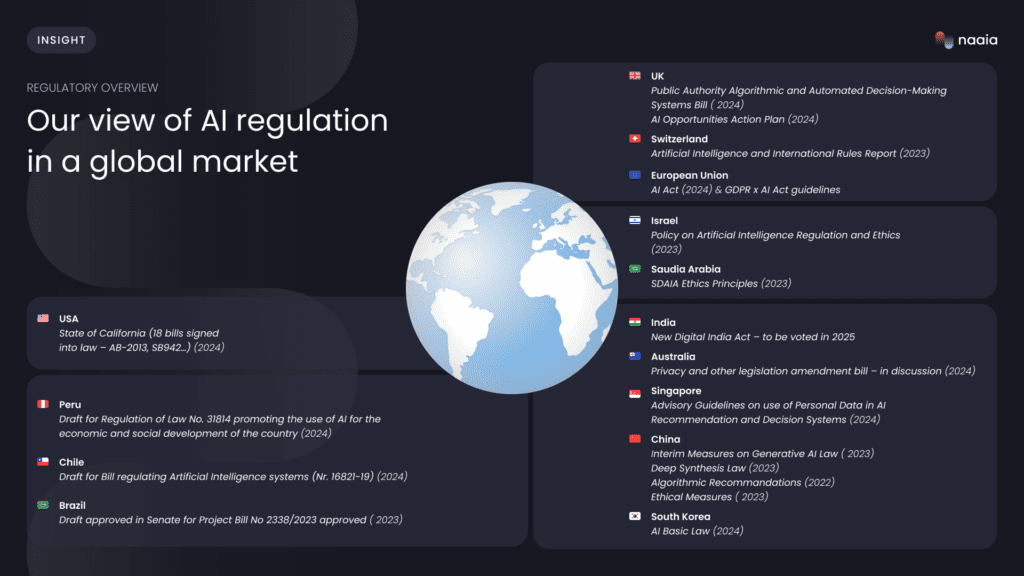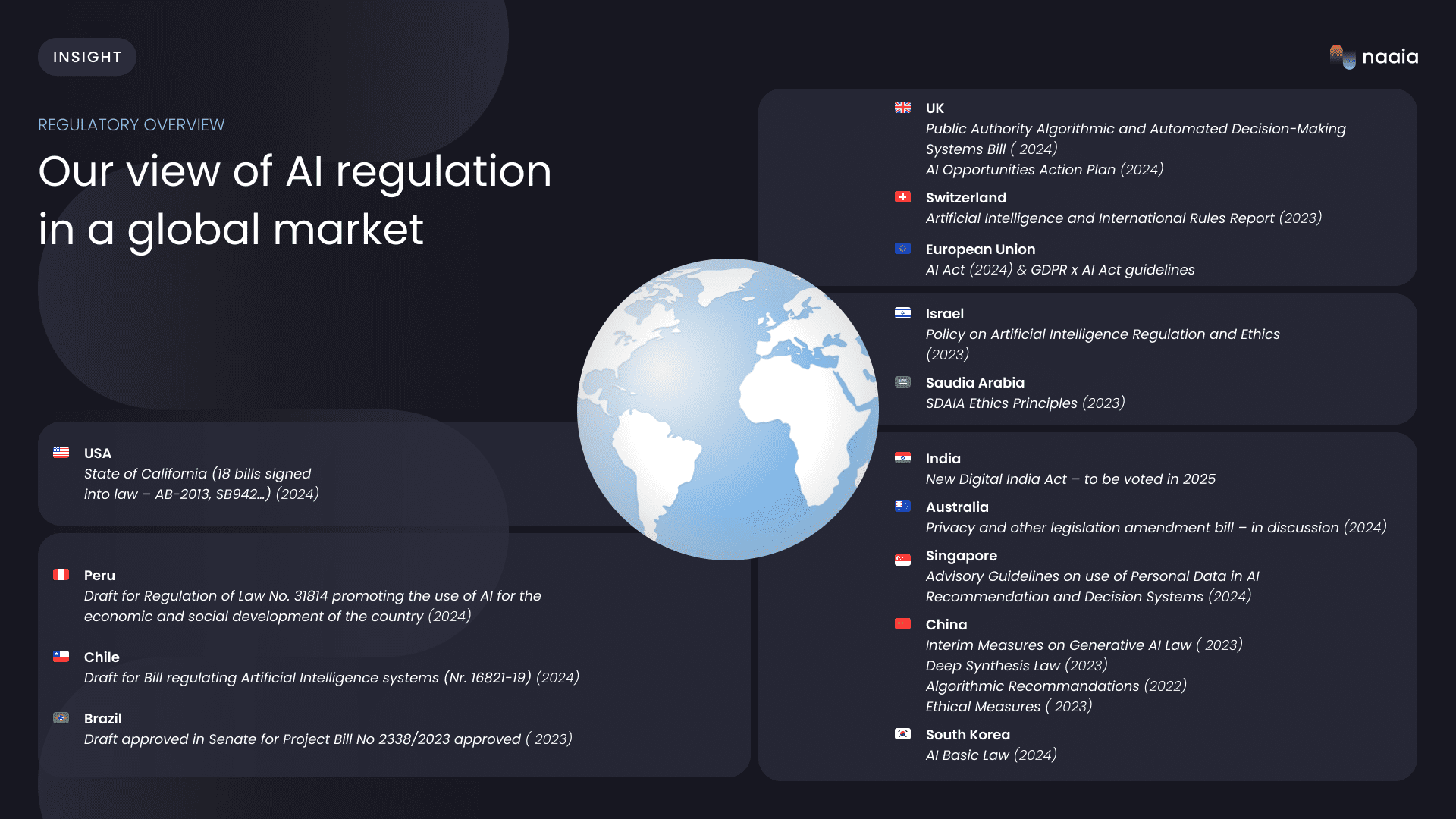Artificial intelligence (AI) is revolutionizing industries from healthcare to finance, but its widespread adoption raises significant ethical and security challenges. In the face of this rise, governments around the world are stepping up their efforts to regulate AI.
The objective? To find a balance between innovation and risk mitigation.
However, the current AI regulatory landscape remains fragmented, often described as a complex “patchwork”, which complicates the implementation of AI standards and harmonized governance. In this article, we explore AI regulatory approaches in different regions of the world, key governance statistics, and prospects for a global AI framework.
What is the current state of artificial intelligence regulation around the world?
In Europe, a pioneering framework for regulating AI
The European Union has adopted a risk-based approach for artificial intelligence systems within the framework of the AI Act. This framework imposes obligations proportionate to the potential impact on security and fundamental rights of individuals for the use cases of AI.
For example, an AI tool designed to correct grammatical errors is classified as a low-risk AI system and is only subject to light requirements. On the other hand, a credit risk assessment system is considered high risk. For this type of system, strict obligations apply, including:
- The creation of complete technical documentation
- The implementation of continuous human control
- The development of an effective risk management system.
These regulations also cover systemic-risk AI models capable of performing a wide range of tasks, such as LLAMA-type models or the GPT series. The aim is to reconcile innovation and the protection of fundamental rights, while guaranteeing the responsible use of AI technologies.
United States: A constantly evolving AI legislative patchwork
In the United States, we observe an absence of a single federal AI framework. This has given rise to a veritable patchwork of laws at the state level.
“In 2024, US lawmakers introduced more than 700 AI-related bills, and 2025 got off to an even faster start, with more than 40 proposals on the books in the first few days of the new year.”
Some states stand out:
- California: more than 25 laws adopted
- Colorado and New York: each with 5 laws entered into force
- Texas: 4 laws already applied
- Washington: 6 laws adopted.
Other states with regulatory activity on AI: Illinois, Louisiana, Connecticut, Tennessee, Utah, Rhode Island, New Jersey, Michigan, Massachusetts, etc.
However, this lack of federal consistency causes problems for companies seeking to comply with multiple regulations. At the same time, some initiatives, such as the Executive Order on Safe, Secure and Trustworthy Artificial Intelligence, were suspended in 2025, illustrating the instability of legislative approaches.
APAC: A diversity of AI approaches according to national priorities
In Asia, countries such as China and South Korea are adopting robust and specific strategies.
China, true to its socialism values, has adopted a vision that favors centralized state control to oversee the development and deployment of artificial intelligence systems with strict rules on transparency and security. For example, AI service providers must label AI-generated content and allow users to opt out of algorithmic recommendations.
Four pieces of AI legislation are currently in force: Interim Measures on Gen AI, which came into force in August 2023, Deep Synthesis, Algorithmic Recommendations and Ethical Measures, and several bills are in the pipeline.
In South Korea, a binding law on AI passed at the end of December 2024, the Basic AI Law, will come into force in January 2026, marking a major milestone in the APAC region.
Singapore, for its part, stands out for its advanced risk management frameworks, including: :
- Review of Observations on the Risk Management of AI Models for Financial Institutions (MAS, 2024), an in-depth assessment for financial institutions.
- Advisory Guidelines on the Use of Personal Data in AI Recommendation and Decision Systems (2024), which addresses issues related to personal data.
In Australia, the Australian National AI Capability Plan (2024) focuses on skills and infrastructure development to strengthen the country’s competitiveness in the field of AI.
Japan offers practical AI guidance such as:
- Guide on Evaluation Perspectives on AI Safety (2024), which examines the safety criteria for AI systems.
- Guidance on AI and Copyright Law (2024), which deals with the implications of AI on copyright.

In other regions : Initiatives are gradually emerging
AI regulation in South America – Brazil, Peru and Chile:
Brazil
Bill No. 2338/23 establishes a national AI framework for the development, use and governance of AI systems. Already adopted by the Senate, it is still awaiting review by the House of Representatives and presidential approval before it can come into force.
Peru
The Regulation of Law No. 31814 aims to promote the use of artificial intelligence with the aim of fostering the country’s economic and social development.
Chile
The Regulation of Law No. 31814 aims to promote the use of artificial intelligence with the aim of fostering the country’s economic and social development.
National bill project in the United Kingdom
The UK AI regulation framework is currently based on two major initiatives: :
- Public Authority Algorithmic and Automated Decision-Making Systems Bill (2024), which aims to regulate the use of algorithms by public institutions.
- AI Opportunities Action Plan (2024), which sets priorities for maximizing the opportunities offered by AI while managing the risks.
AI regulations in Saudi Arabia
Saudi Arabia has published several guidelines, including :
- SDAIA Ethics Principles (2023), a set of ethical principles with a risk-based approach.
- Guidelines for Generative AI (2024), which regulate the specific uses of generative AI.
Regional and international organisations
Efforts to regulate AI are not limited to states. Several international and regional organizations play a key role in developing collaborative frameworks:
- Council of Europe: Development of standards for human rights and AI governance.
- WTO and ILO: Analysis of the economic and social impacts of AI technologies.
- UN / UNESCO: Promotion of an ethical and inclusive approach.
- ASEAN: Initiatives to strengthen regional cooperation on AI.
- BRICS: Establishment of mechanisms for technological collaboration.
- G7 / G20: Policy coordination between major world powers.
- OECD: Development of guiding principles for responsible AI.
Key figures shaping the landscape of AI governance
Statistics on AI governance show how much of a global priority this topic is. According to the OECD, there are currently more than 2,083 initiatives worldwide:
- 426 policies adopted
- 401 policies under discussion
- 28 policies revoked or rejected.
Regulatory responses include:
- 259 laws
- 216 guidelines
- 130 ordinances
- 71 investigations.
These figures show that, although many efforts are underway, much remains to be done to harmonize existing frameworks.
Let’s prepare for a harmonized future of artificial intelligence.
For us, AI regulation is an opportunity to ensure ethical and sustainable technological development. Frameworks such as the AI Act in Europe provide a solid foundation, but international collaboration will be essential to overcome the challenges of the current fragmentation.
We invite companies to adopt a proactive approach: :
- Integrate security standards now
- Monitor legislative trends
- Collaborate with regulators to anticipate developments.
With joint efforts, we can ensure that AI continues to transform our societies in a positive way while respecting fundamental values.
Naaia acts as a one-stop shop for organizations. All compliance and risk management needs are covered with limited effort.
Would you like to discover the Naaia platform? Feel free to request a demo!
